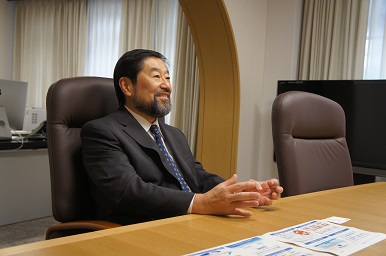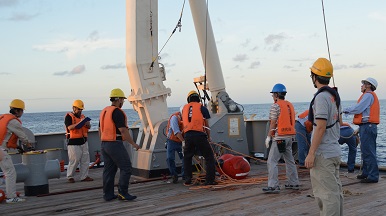Areas managed: international affairs, the University Hospitals

Ken Furuya
Graduated from the University of Tokyo's Faculty of Science in 1975. Received a Doctoral degree from the University's Graduate School of Agriculture in 1981. Became a professor of the Graduate School of Agricultural and Life Sciences in 1999. Became the dean of the Faculty of Agriculture/the Graduate School of Agricultural and Life Sciences in 2013. Area of specialty: aquatic bioscience
Graduated from the University of Tokyo's Faculty of Science in 1975. Received a Doctoral degree from the University's Graduate School of Agriculture in 1981. Became a professor of the Graduate School of Agricultural and Life Sciences in 1999. Became the dean of the Faculty of Agriculture/the Graduate School of Agricultural and Life Sciences in 2013. Area of specialty: aquatic bioscience
What points do you think are important when trying to promote the further internationalization of the University of Tokyo?
One important point is that the University of Tokyo is a research university located in a non-English-speaking country. The University has achieved a high level of education and research based in the Japanese language and backed by a social environment that differs from those in America and Europe. The University is situated in an important position for academic diversity because it has deepened academic understanding by incorporating Western knowledge into its solid foundation in Eastern culture. For example, the University can make an unparalleled contribution by promoting interdisciplinary research covering areas that reflect Japan's history and culture, such as the humanities and social sciences, and communicating the results of such research to the world.
I would like to focus particularly on educational activities. International experiences are very effective in further developing students' excellent intellectual abilities. Students can acquire the intelligence to examine themselves objectively by placing themselves in environments different from the ones they are used to and acknowledging diverse ways of thinking. However, allocating public money to financially support these international activities is not easy. So, I will ask alumni to support our students in having international experiences.
International collaboration in research is already active at the level of individuals, the Faculties, the Graduate Schools and the Institutes. Expanding these collaborations to an inter-university level is sure to have a positive effect on education as well. The University has been selected to receive funds from the Top Global University Project financed by the Ministry of Education, Culture, Sports, Science and Technology (MEXT). Considering this selection as motivation to further internationalize the University, we will establish a global campus model unique to Japan that is constructed using the Comprehensive Reform of Undergraduate Education and the Strategic Partnerships.
I would like to focus particularly on educational activities. International experiences are very effective in further developing students' excellent intellectual abilities. Students can acquire the intelligence to examine themselves objectively by placing themselves in environments different from the ones they are used to and acknowledging diverse ways of thinking. However, allocating public money to financially support these international activities is not easy. So, I will ask alumni to support our students in having international experiences.
International collaboration in research is already active at the level of individuals, the Faculties, the Graduate Schools and the Institutes. Expanding these collaborations to an inter-university level is sure to have a positive effect on education as well. The University has been selected to receive funds from the Top Global University Project financed by the Ministry of Education, Culture, Sports, Science and Technology (MEXT). Considering this selection as motivation to further internationalize the University, we will establish a global campus model unique to Japan that is constructed using the Comprehensive Reform of Undergraduate Education and the Strategic Partnerships.
You also work as the director of the University of Tokyo Institutes for Advanced Study (UTIAS).
UTIAS is composed of two institutes, the Kavli Institute for the Physics and Mathematics of the Universe (Kavli IPMU) and the Integrated Research System for Sustainability Science (IR3S). The former has established a system for bringing in excellent researchers from nations around the world, as well as other internationalization measures. The latter has joined a wide range of international collaboration projects to create a sustainable society. Both organizations of UTIAS have provided good examples of internationalization that other University organizations can follow.
What do you think about the University Hospitals that you also supervise as an executive vice president?
The top priority is, needless to say, to further refine the world-leading medical care, education and research provided by the Hospitals. Considering the recent boom of interdisciplinary projects in the medical field, such as collaboration between medicine and engineering, it is also important for the Hospitals to develop these initiatives into their strength in the future. Our immediate goal is to reorganize the Hospitals to function as the core hospitals in charge of clinical research specified by the Ministry of Health, Labour and Welfare.
Could you talk about your research areas of aquatic biology and environmental science?
Research themes in this field cover the aquatic environment and the ecology of aquatic organisms. My specialization is in marine phytoplankton. I have investigated the roles that marine phytoplankton play within the ecosystem. In other words, I have tried to unravel the mystery of ecological phenomena from a physiological perspective. Because my research targets are marine organisms, I spent a large amount of time conducting fieldwork on research vessels. As the conditions of marine organisms change if they are brought into a laboratory, I carried out many experiments on board.
One memorable experience I had was when I was a first-year Master’s student and I went on my first three-month fieldwork expedition on a ship in the Indian Ocean. I was surprised at how the color of the ocean changed as our ship moved forward; rather than the sea being the same everywhere, I realized that it is a place teeming with diversity. It was also exciting for me to get to know my fellow researchers on board the ship, who were from all over Japan and studied in a wide range of fields.
I like climbing mountains, so I vaguely planned to research the ecology of alpine plants when I studied at the Junior Division of the College of Arts and Sciences on the Komaba Campus. After enrolling in the Faculty of Science, however, I changed my research area from the mountains to the sea because I was influenced both personally and academically by my tutor, a marine biologist who worked as a research associate. To be honest, though, I used to get seasick easily.
One memorable experience I had was when I was a first-year Master’s student and I went on my first three-month fieldwork expedition on a ship in the Indian Ocean. I was surprised at how the color of the ocean changed as our ship moved forward; rather than the sea being the same everywhere, I realized that it is a place teeming with diversity. It was also exciting for me to get to know my fellow researchers on board the ship, who were from all over Japan and studied in a wide range of fields.
I like climbing mountains, so I vaguely planned to research the ecology of alpine plants when I studied at the Junior Division of the College of Arts and Sciences on the Komaba Campus. After enrolling in the Faculty of Science, however, I changed my research area from the mountains to the sea because I was influenced both personally and academically by my tutor, a marine biologist who worked as a research associate. To be honest, though, I used to get seasick easily.
One could say that your mustache and beard are your "trademark."
Every time I got back from conducting fieldwork in the sea, I shaved the stubble that had grown during the voyage. I left it unshaved after my voyage in 1987, though, and it's been there ever since.

* This interview was originally printed in Tansei 31 (Japanese language only).






